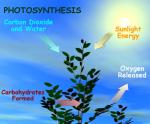|
This section contains 244 words (approx. 1 page at 300 words per page) |
Photosynthesis
The chlorophyll found in the chloroplasts absorbs sunlight. Chloroplasts are oval bodies, which contain the green pigment chlorophyll. The chlorophyll absorbs light energy and then converts it into chemical energy for photosynthesis. The food produced is then stored as starch in the form of starch granules. The greatest number of chloroplasts is found in the palisade layer as it receives more sunlight.
Carbon dioxide and oxygen are exchanged with the atmosphere by diffusion through the stomata. The stomata also allow the diffusion of water vapour out of the leaf. Stomata are tiny pores found in the upper epidermis and the lower epidermis of the leaf but the lower epidermis has the greatest number stomata.
Because of the large air spaces between the spongy mesophyll cells, carbon dioxide diffuses rapidly through the stomata to the palisade cells. The spongy mesophyll cells are loosely packed to form these large air spaces and they contain fewer chloroplasts.
The water needed is absorbed from the soil by the roots. The water is then transported to the leaves by the xylem. The veins of the leaf consist of xylem and phloem. The xylem vessels are made of large hollow dead cells. They transport water and mineral salts throughout the plant. The phloem takes away the manufactured food from the leaves to the other parts of the plants.
|
This section contains 244 words (approx. 1 page at 300 words per page) |


